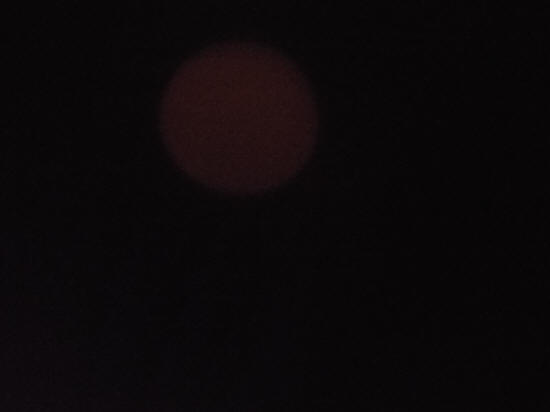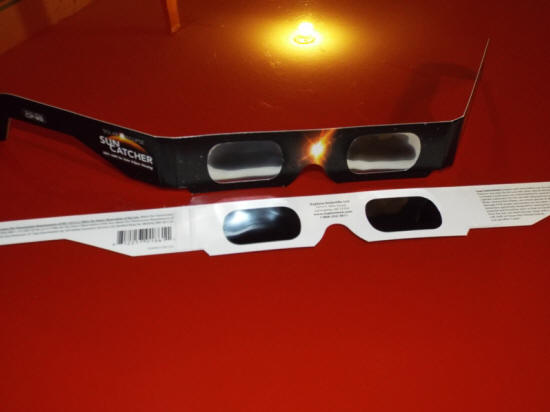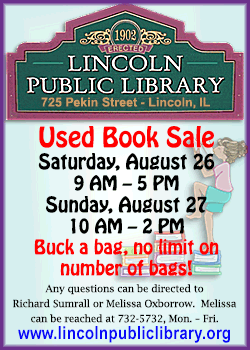|
How to Tell If Your Eclipse
Glasses or Handheld Solar Viewers Are Safe
 Send a link to a friend
Send a link to a friend
 [August 18, 2017]
Short
Answer [August 18, 2017]
Short
Answer
We used to say that you should look for evidence that they comply
with the ISO 12312-2 international safety standard for filters for
direct viewing of the Sun. But now the marketplace is being flooded
by counterfeit eclipse glasses that are labeled as if they're
ISO-compliant when in fact they are not. So now we suggest that you
make sure you get (or got) your eclipse viewers from one of the
suppliers listed on our
Reputable
Vendors of Solar Filters & Viewers page.
Long Answer
The #1 rule for observing a solar eclipse, or for looking directly
at the Sun at any other time, is safety first.
As noted elsewhere on this site, with one exception, it is never
safe to look directly at the Sun without a special-purpose safe
solar filter. That exception is during totality, when the Moon
completely blocks the dazzlingly bright face of the Sun. On August
21, 2017, this will happen only within the roughly 70-mile-wide path
of the Moon's dark inner shadow from Oregon to South Carolina — and
only for a minute or two. Before and after totality, and at all
times outside the path of totality, you must use a special-purpose
safe solar filter when looking directly at the Sun.

"Special-purpose" means designed exclusively for looking directly at
the everyday Sun. Filters for direct viewing of the Sun are
typically sold in the form of wearable “eclipse glasses” or "eclipse
shades" or as solar viewing cards that you hold in your hand. What
makes them special is that they reduce sunlight to safe levels so
that you don't injure your eyes. Our daytime star shines about a
half million times brighter than the full Moon in visible light and
emits potentially harmful ultraviolet (UV) and infrared (IR)
radiation too. Looking directly at the Sun through anything that
isn't specially made to deal with all that visible light and
invisible radiation is a recipe for serious eye injury, perhaps even
blindness. Note that special-purpose solar filters are many
thousands of times darker than ordinary sunglasses!
What to Look For
How do you know if your eclipse glasses or handheld solar viewers
are truly safe? You need to know that they meet the ISO 12312-2
(sometimes written as ISO 12312-2:2015) international safety
standard. Filters that are ISO 12312-2 compliant not only reduce
visible sunlight to safe and comfortable levels but also block solar
UV and IR radiation.
Unfortunately, you can't check whether a filter meets the ISO
standard yourself — doing so requires a specialized and expensive
piece of laboratory equipment called a spectrophotometer that shines
intense UV, visible, and IR light through the filter and measures
how much gets through at each wavelength. Solar filter manufacturers
send their products to specialized labs that are accredited to
perform the tests necessary to verify compliance with the ISO
12312-2 safety specifications. Once they have the paperwork that
documents their products as ISO-compliant, they can legitimately use
the ISO logo on their products and packaging.
Even more unfortunately, unscrupulous vendors can grab the ISO logo
off the internet and put it on their products and packaging even if
their eclipse glasses or viewers haven't been properly tested. This
means that just seeing the ISO logo or a label claiming ISO 12312-2
certification isn't good enough. You need to know that the product
comes from a reputable manufacturer or one of their authorized
dealers.

The AAS Solar Eclipse Task Force has been working diligently to
compile a list of such vendors, now posted on our Reputable Vendors
of Solar Filters & Viewers page. We've checked manufacturers' ISO
paperwork to make sure it's complete and that it comes from a
recognized, accredited testing facility, and we've personally
examined manufacturers' products. We've asked manufacturers to
identify their authorized resellers, and we've asked dealers to
identify the source of the products they're selling. Only when
everything checks out do we add a vendor to our listing.
If we don't list a supplier, that doesn't mean their products are
unsafe — only that we have no knowledge of them or that we haven't
convinced ourselves they are safe.
How can you tell if your solar viewer is not safe?
You shouldn't be able to see anything through a safe solar filter
except the Sun itself or something comparably bright, such as the
Sun reflected in a mirror, a sunglint off shiny metal, the hot
filament of an unfrosted incandescent light bulb, a bright halogen
light bulb, a bright-white LED bulb (including the flashlight on
your smartphone), a bare compact fluorescent (CFL) bulb, or an
arc-welding torch.

All such
sources (except perhaps the welding torch) should appear quite dim
through a solar viewer. If you can see shaded lamps or other common
household light fixtures (not bare bulbs) of more ordinary
brightness through your eclipse glasses or handheld viewer, and
you're not sure the product came from a reputable vendor, it’s no
good. Safe solar filters produce a view of the Sun that is
comfortably bright (like the full Moon), in focus, and surrounded by
dark sky. If you glance at the Sun through your solar filter and
find it uncomfortably bright, out of focus, and/or surrounded by a
bright haze, it’s no good. You should contact the seller and demand
a refund or credit for return of the product, then obtain a
replacement from one of the sources listed on our reputable-vendors
page.
[to top of second column] |


Remember that a genuinely safe solar viewer does more
than reduce the Sun's visible light to a comfortable brightness
level. It also blocks potentially harmful UV and IR radiation. The
only way to tell whether your viewer does that is to be certain that
it meets the ISO 12312-2 safety standard, and the only way to know
that is to be certain that it came from a reputable vendor.
What if you received eclipse glasses or a handheld solar viewer from
a relative, friend, neighbor, or acquaintance? If that person is an
amateur or professional astronomer — and astronomers have been
handing out eclipse viewers like Halloween candy lately — they're
almost certainly ISO-compliant, because astronomers usually get
their solar filters from sources they know and trust (in other
words, from the ones listed on our reputable-vendors page). Ditto
for professional astronomical organizations (including college and
university physics and astronomy departments) and amateur-astronomy
clubs.
If you
bought or were given eclipse viewers at a science museum or
planetarium, or at an astronomy trade show, again you're almost
certainly in possession of ISO-compliant filters. As long as you can
trace your filters to a reputable vendor or other reliable source,
and as long as they have the ISO logo and a statement attesting to
their ISO 12312-2 compliance, you should have nothing to worry
about. What you absolutely should not do is search for eclipse
glasses on the internet and buy whatever pops up in the ads or
search results. Check our list of reputable vendors and buy from one
of them.
In addition to making sure your eclipse shades or handheld viewers
come from a reputable source, make sure they're in good condition:
If the filters are torn, scratched, or punctured, discard them.
If the filters are coming loose from their cardboard or plastic
frames, discard them.

Note: If your eclipse glasses or viewers are compliant with
the ISO 12312-2 safety standard adopted in 2015, you may look at the
uneclipsed or partially eclipsed Sun through them for as long as you
wish. Furthermore, if the filters aren't scratched, punctured, or
torn, you may reuse them indefinitely. Some glasses/viewers — even
new ones — are printed with warnings stating that you shouldn't look
through them for more than 3 minutes at a time and that you should
discard them if they are more than 3 years old. Such warnings do not
apply to eclipse viewers certified to meet the ISO 12312-2:2015
standard and may be ignored. Then again, why would you stare at the
Sun for more than 3 minutes? A partial eclipse progresses so slowly
that there's no point in looking at it for more than a few seconds
every few minutes.
What to Avoid
Ordinary sunglasses (or multiple pairs of sunglasses), neutral
density or polarizing filters (such as those made for camera
lenses), smoked glass, photographic or X-ray film (unexposed,
exposed, or developed), "space blankets," potato-chip bags, DVDs,
and any other materials you may have heard about for solar viewing
are not safe. In some cases these homemade filters may seem like
they dim the Sun to a comfortable level, but that doesn't mean they
do so across the whole electromagnetic spectrum. While you're
enjoying a "comfortable" view of the "dim" Sun, solar infrared
radiation could be cooking your retinas. And you wouldn't know till
later, because your retinas don't have pain receptors. Only after
the eclipse, when you notice blind spots or other vision problems,
would you realize you'd made a catastrophic mistake.
What about welding filters? The only ones that are safe for direct
viewing of the Sun with your eyes are those of Shade 12 or higher.
These are much darker than the filters used for most kinds of
welding. If you have an old welder's helmet around the house and are
thinking of using it to view the Sun, make sure you know the
filter's shade number. If it's less than 12 (and it probably is),
don't even think about using it to look at the Sun. Many people find
the Sun too bright even in a Shade 12 filter, and some find the Sun
too dim in a Shade 14 filter — but Shade 13 filters are uncommon and
can be hard to find. In any case, welding filters generally give a
sickly green image of the Sun, whereas special-purpose solar viewers
give a white, yellow, or orange image, which is much more pleasing
and natural. If you really want to get a welding filter, we
recommend that you buy it from a welding supply company; we've heard
reports of people ordering "Shade 14" welding goggles from random
online stores and receiving much lighter filters than they were
promised. Our Reputable Vendors of Solar Filters & Viewers page
doesn't list any suppliers of welder's filters, only suppliers of
filters made exclusively for viewing the Sun.
[American Astronomical Society
National Science Foundation]

 |